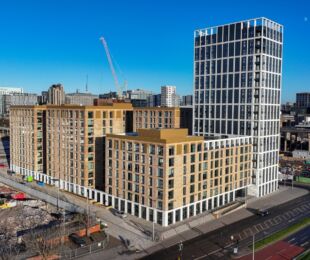
This inspired development for Enfield Council was built on an old council depot site. It lies between a suburban neighbourhood and a rural area containing a park and wetland nature reserve. The land has been re-activated and redefined with 50 low-energy homes and an ecologically rich open public space.
Built by developer Hill Partnerships and designed by architects Karakusevic Carson Architects, the new detached and semidetached homes are two to three storeys high and contain two to four bedrooms. They offer spacious, high quality, exemplar living. However, what makes this development standout is its sensitive and innovative approach to landscape-led development.
The scheme reflects the homes’ green location by utilising the architectural language of farm buildings. Indeed, the homes themselves are reminiscent of simple barn-like structures within a field. These vary in width and height to accommodate a range of interior layouts.
Pitched roofs and strong gable ends characterise the buildings, along with a paired-back palette of brickwork and the presence of timber louvres, which also recall agricultural forms. Diamond and staggered protruding brickwork adds texture to blank facades and articulates and enhances the simple domestic forms. Lines of projecting bricks also feature underneath windows to add visual interest.
A selection of bricks were chosen with each house assigned a
brick tone to further enhance the patchwork quality of the field of houses. Two
of the bricks selected were Ibstock’s Birtley Browns and Olde English Greys,
which were chosen for their earthy tones. The brown tones of the former and the
greys of the latter underline the part-rural and part-urban setting. They also
complement the large glazed and wooden panels that feature on some elevations.
The site also has a sense of openness throughout. In response, homes are offset
from one another to form a staggered patchwork arrangement, with dwellings
organised between gardens and vehicular yards in a pattern that mimics the
layout of nearby allotments. Meanwhile, the homes were aligned to maximise
southern aspect and benefit from increased natural light and enhanced thermal
performance.
As one might expect, the development also boasts excellent sustainability and biodiversity credentials. Due to the sloping nature of the site to the south, sustainable urban drainage strategies were devised, with regular rain gardens slowing the movement of water towards a brook. Here an open, bio-diverse wildflower meadow provides a natural, open space for community recreation.
These natural qualities are extended through the scheme, with street gardens and trees that further enhance bio-diversity. The homes also possess solar panels and are each provided with a car charging point.







